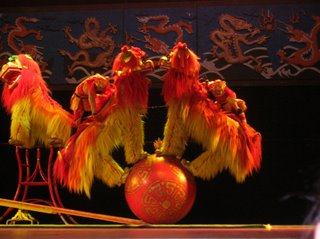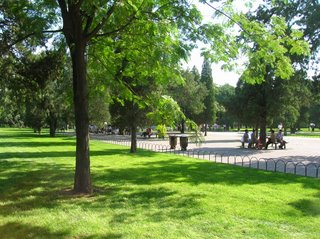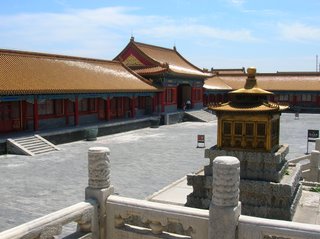Last Friday morning we had an organized ‘field trip’ to Tiananmen Square as part of our history class (from Singapore). The only thing that we did officially as a group was to file through Mao’s Mausoleum. When he died in 1976, his body was embalmed and placed on display in his newly-built mausoleum. It is smack dab in the middle of Tiananmen Square, the largest paved open space in the world. It was incredible how many people are always there to file past his body. We weren’t allowed to bring in any bags, cameras, etc, so Professor Zhou and our graduate assistant Chien-Hung stayed outside to hold everything. We were fairly shoved into double-file lines to snake our way across the square before entering the mausoleum. On the way in you can jump out of line to purchase a rose to place on Mao’s shrine directly inside the entrance (his shrine, not his body; two different things). His body is under glass in the back room. The line splits into two, one to go down each side and the file out the back door.
After the mausoleum, the group split up to do our separate activities. Tiananmen Square has a lot of famous buildings around it, such as the Forbidden City, the Great Hall of the People, and the Monument to the People’s Heroes, so most of us took a stroll across the square before heading off in our different directions. I ended up going shopping with Marianna and Chao (a Tsinghua student in our class) for knick-knacks and more chopsticks before getting lunch. We had an amazing lunch. Everyone says that if you come to Beijing, you have to have peking duck, and they are correct. We went to a restaurant that is famous for their duck, the Quanjude Roast Duck Restaurant. This was by far the nicest place I have been in Asia. We arrived right after noon, and we were the first customers in the restaurant. Everyone jumped to attention as soon as we walked in. We were ushered to a table right in the middle of the restaurant and then six different waiters swarmed us, trying to pull out our chairs, place napkins across our laps, and set up our utensils. We ordered a roast (peking) duck, which came with soup, sauce, onions and other seasonings, and ‘pancakes,’ as well as duck-filled spring rolls. They brought the duck to our table and carved it in front of us! The way to eat duck in Beijing is to hold your pancake (made of a thin bread, like the kind used in dumplings) flat in your hand, spread several pieces of duck and onions inside, fold it up into a square, and dip it in the sauce. We invented new ways of making the pancakes, and it was delicious. What a good meal!
After lunch, we wandered back to Tiananmen Square to go to the National Museum. They had many different exhibits, everything from Chinese culture to art to Incan artifacts. In the same complex is a museum of the Chinese Communist Party and Museum of the Chinese Revolution. My guidebook says that they were closed from 1966 to 1978 ‘so that history could be revived in light of recent events.’ Apparently that still happens today!
By the time we were done with the museum, we didn’t have time to do either the Forbidden City or the Temple of Heaven, both of which should take about half a day, so we ended up just coming back to Tsinghua. It was almost 6.30 by the time we got home, so we went right to dinner. We relaxed that night because we had a big day the next day.
Earlier in the week we had made arrangements for our entire group plus some of the NUS and Tsinghua students to venture out to see the Great Wall of China. After asking our friends who had done this program before and our professor, we decided to make the long drive (roughly four hours) out to the Simatai section. There are several sections of the Great Wall around Beijing, but the ones closer to the city are more touristed and artificial (so we hear). I am very happy that we made the long drive out to Simatai because we saw almost no tourists (as compared to the wall-to-wall tourists that supposedly visit the closer sections in the summer months).
Simatai was built during the Ming dynasty. We were able to climb to 12 of the 16 watchtowers; the remaining four are crumbling so terribly that tourists are not allowed to attempt them without special permission. Some of the staircases (and I use the term ‘staircases’ very loosely) between watchtowers are at 70 degree inclines; thankfully, so were the staircases we climbed in Cambodia, so we’d had practice! The views were absolutely spectacular. We were in the middle of no where with the most brilliant day we’ve had the entire time we’ve been in China. There was just a smattering of clouds and a light breeze, which, considering the strong sun and the fact that we’re climbing 70 degree staircases, felt very good at the top. There is a river running along the mountains ending in a dam, and the rolling mountains meeting the water was so gorgeous that it reminded me of New Zealand. I’ve been told that the air was thinner at the top, but I didn’t notice it as it was the cleanest air I have experienced since being in China.
One of the craziest parts of the Great Wall is the amount of hawkers who follow you around. I don’t know if it is like this on the other sections, but I was amused by it at Simatai. It works like this: a lady will attach herself to your side, fanning you the whole way up the wall, helping you up and down precarious ledges, taking group and single pictures for you, and generally being a companion until you get to the top, at which point she wants you to buy everything that she has. They’re really very nice, and I had fun joking around with a lady who attached herself to my group. I bought a fan from her for twice what I should have paid for it, but I told her I knew that I was overpaying and it was only because I had so much fun with her climbing up the wall. (By overpay twice as much, I mean I paid 20 yuan instead of 10 yuan. That’s US$2.5 instead of US$1.25.) We had a large group walking up the wall, so she was one of several ladies walking with us, and as a group they were just as amused with us as we were with them! We tended to take crazy pictures, and in between watchtowers they helped to teach us more Chinese. It was a good situation and a great day.
Oh, one other thing about the wall. Because this section is so precarious, there is a cable car that runs up and down for those who want to avoid broken ankles and such. Most of our group took the cable car on the way down, but several of us had other plans. On the way up, we had passed a flying fox (zip line) that crossed the water down to the other side. We couldn’t not do the zip line, so we walked back down the wall (it only took about 10 minutes) and found the entrance. It wasn’t much more than the cable car (only about 5 yuan),and after the flying fox we got to ride in a boat down the river to the carpark (at which point we bargained with more hawkers for more drinks and souvenirs). We had already all purchased popsicles at the top of the Wall, but after our strenuous day we all needed more drinks.
Even though we were all exhausted after that day, we found the energy to take showers and go out to the International Beer Garden to watch the England v Portugal game. There were a lot more foreigners than I expected, and there was an especial majority of English fans. There were so many people that we had to split into shifts to get dinner in order to save our chairs and tables! We at the at budget Italian restaurant that is very close to campus that evening. We’re all beginning to get a little tired of ‘real’ Asian food, even the die hard Asian food fanatics, so every once in awhile some Western cuisine is necessary.
The next day was filled with schoolwork and shopping along with a nicer dinner. We are heading to Shanghai this weekend and plan to do some major shopping for fake purses and real pearls, but in order to make a good comparison we needed to first discover what Beijing had to offer. So, we headed to the official pearl market that also has floors of electronics, clothes, shoes, toys, fake jewelry, and purses. We had done a lot of research to make sure we didn’t get scammed buying pearls, so we knew the reputable places to look in this market. Not too many people purchased anything as this was just an investigation (purchasing will come after the trip to Shanghai), but we didn’t come away empty handed! All of us bought at least one purse, and Carlanna even picked up a fake iPod Nano. This is definitely a market we will be returning to. We’re learning to be hard bargainers, and while some of us are better than others, we’re all pretty good at sticking to what we want to pay. When Marianna was bargaining for her purse and the lady wouldn’t drop her price, we walked away. We made it halfway down the aisle (and these are LONG aisles) with the lady desperately calling prices after us before she dropped down to the one that we wanted. When Marianna went back to retrieve her purchase, the lady said something to the effect of, ‘You not American! You not American! You Pakistani the way you bargain!’ It was pretty funny.
After the market we met up with the Shanghai people. Georgia Tech runs two summer programs in China, the one that I am on and one that only goes to Shanghai. Several of the Shanghai students were in Beijing this weekend, so we took a taxi to their hotel to have dinner with them. It was nice seeing people from back home (as well as new people) again. We couldn’t stay out with them because we have so much schoolwork to do. It’s really piling on right now. For this class, which is 2.5 weeks long (Mon-Thurs, Mon-Thurs, and a final on Wed) we have two midterms, several homeworks, three projects (two of which have papers, one of which has a presentation), and a final. We’ve already made it through one Mon-Thurs, one Monday, and one midterm, which means we have many more to go with not much time left. We have Tuesday, Wednesday, Thursday day (because we are leaving Thursday night for Shanghai), Monday, and Tuesday to complete the three projects (two papers, one presentation), one midterm, homeworks, and the final. Wish us luck not collapsing!












































